There are always ways to spring something familiar with a bit of new excitement, and this is an attribute that fuels the fields of art, entertainment, and games. Inventiveness is crucial to rekindling the excitement players hold for games of a certain genre like word games.
For instance, Wordle, the viral sensation, has banked on the advantage of divergent thinking to reinvigorate the player base of word guessing by infusing it with new layers of challenges. But, today, our focus is not on Wordle, because it has been brought to our attention that a new word game is here to hijack all conversations.
Yes, we are talking about Knotwords. If you are curious to know just what exactly it is, come along to take a closer look.
What is Knotwords?
If you have a proud second persona as a super enthusiast of logic-based puzzle games, then Knotwords just might be the next one in line to feed your addiction. It is a sudoku-ish word game with a crossword-like DNA fundamentally principled on solving grids that are near-perfect simulacrums of tower-like structures.
The game was officially launched on major app stores like App Store and PlayStore on April 28th, 2022. Developed by Zach Gage and Jack Schlesinger, Knotwords is a word-based reworking of the mechanics of math-based games like KenKen and nonograms.
In appearance, it resembles a crossword, but instead of a list of direct hints like a word’s definition or explanatory statement that you typically get in a crosswords puzzle, on Knotwords you take cues from the preset letter groups that mark different zones. Your challenge is to use these letters within their designated zones to form valid words vertically or horizontally.
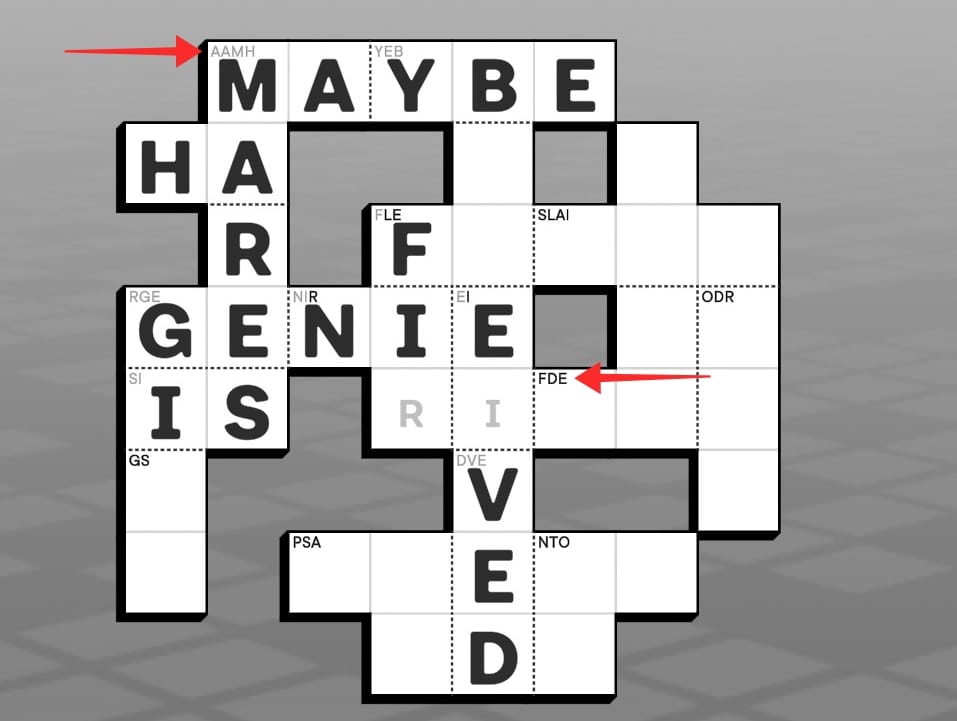
This might ring a bell if you are familiar with the arithmetic equations in a KenKen game and the adjacent grid formula used in Nonogram puzzles. To supplement these preset compulsory letters, you can even ask for “detailed” hints from the system to exit bottlenecks in the game.
The brains and inspirations behind Knotwords
Knotwords is the brainchild of seasoned mobile game developers, Jack Schlesinger and Zach Gage, who have already won the hearts of word and logic puzzle enthusiasts with games like Spell Tower and Good Sudoku.
Following the successful formula of revamping familiar puzzle boards with untried infusions of new challenges, the New-York based game designer/developer duo has created Knotwords with bones and marrow taken from other games of the logic puzzle genre like Sudoku, KenKen, and Nonograms.
Apart from the mechanism, something that had a formative influence on the game model, according to it its developers is Wordle. Schlesinger and Gage also hope that Knotwords would become something of a ritual that effortlessly blends into your daily routine that gets done with an ever-burning passion like the New York Times Crossword or Wordle.
Where to play Knotwords?
Knotwords is available for download from all the major app markets so get your Apple and Android devices (phones and tabs), Mac, and Desktops ready to play Knotwords before anyone. Click here to add Knotwords to your wish list.
Get Knotwords:
- Google Play Store (Android)
- Apple App Store (iPad and iPhone)
- Steam (for PC and Mac)
Knotwords has a free Daily Classic mode that any player can take on to enjoy one free daily challenge in addition to 10 monthly challenges. To play past the restriction and access additional challenges along with complete access to the game archive, you need to make a one-time subscription for $11.99 or an annual subscription of $4.99.
The mobile apps (Apple and Android) both allow a free daily game to unsubscribed players, a benefit that you cannot enjoy if you wish to play the game on PC or Mac. There is a special inaugural promo discount of 10% up for grabs until May 5th, 2022 if you download it from Steam
How to play Knotwords
To play Knotwords, you need to understand how the letter groups and the zones they form are not just informative cues but a set of prefixed and unbending conditions dictating the gameplay. To understand it better, let’s think of a crossword or sudoku puzzle. In a typical game, you can enter your guesses anywhere on the blank grid and adjust or replace these letters/numbers as you go to satisfy the logic of the game.
However, on Knotwords, your maneuvers are restricted to zones. Within a zone, you may move freely but cannot stray outside. The more zones you complete, the narrower the scope of your guesses gets. If you solve it word by word, zone by zone, Knotwords is not that difficult to beat.
Here comes the most exciting part — in Knotwords, the concept of streak comes with a little bit more weight than on a Wordle scoreboard. Here, the puzzles get progressively difficult with each game, where you start a week with a relatively easier, smaller puzzle grid that gets larger and tougher with each new game the following day of the week.
If you plan to subscribe to the game, there is more in store for you. Apart from the Daily Classic mode (which is free for mobile app players), Knotwords has a Daily Twist mode in which there is a cap set on the number of times that vowels may be used in a given row or column. Under the “Monthly puzzlebooks” (the game archive), paid subscribers also get access to Tricky Puzzles which only take adjectives for answers to solve the challenge grid.
Knotwords rules: Zones and letter groups explained
Knotwords is simple to play as long you as manage to grasp the logic intended to be satisfied in the game. When you start a Knotwords puzzle, you already have several sets of hints available on the otherwise blank grid in the form of preset letters. The grid itself is segmented into various Tetris-like “O”, “T”, “L”, “J” or “I” like zones depending on the number of letters in a letter cluster and their position in the grid. The letter groups that form a zone are mandated to be present in the words form, both across and down.
For instance, in the screenshot below, the letter group R-G allows you to use only “G” or “R” in the two-tile zone it opens. The “G” and “R” are compulsory to be present in the word formed “down” while either “G” or “R” could be a part of the word formed “across” in Row 2.

Similarly, when you are in the “T” zone set off by the E-S-K-I letter group in Row 2, Tile 4, you get 4 tiles highlighted in a nanogram (adjacent tiles) format that can only be filled using the preset letters of the zone (E-S-K-I).
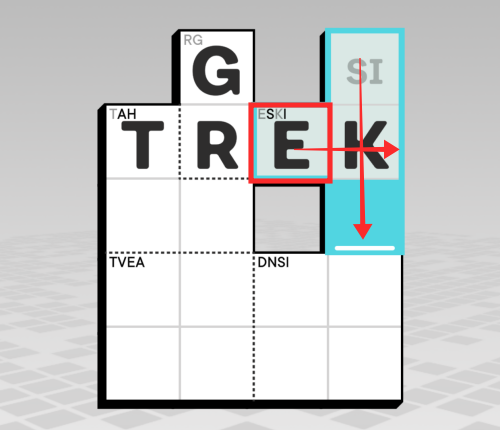
Although you can input the allowed letters in any tile in a selected zone without restriction, cross-zone maneuvers are not allowed on Knotwords. That is to say, you cannot use the letter groups to directly solve the grid as a whole or move across or down in a free and orderless fashion but only solve the puzzle bit by bit by filling up the tiles in each zone. The on-screen keyboard also disables all the letters other than the ones allowed in the zone to enforce this rule.
If you enter invalid words or words that clash with the letter clusters in a zone, they get highlighted with a pink scribble-crossout. If you see one on your grid, then it is a sure indicator that your letters within the zone clash, and hence the correct word is blocked from being revealed.
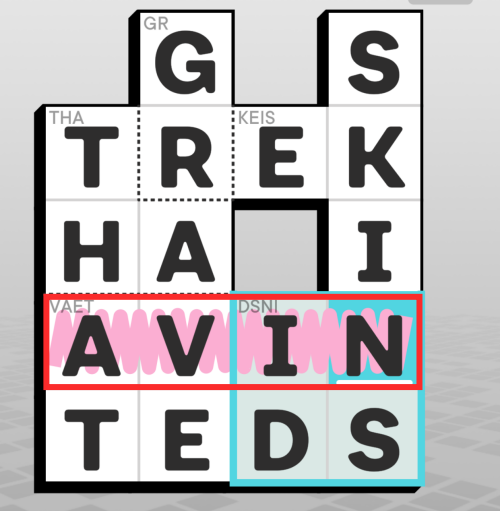
Knotwords Gameplay: Moves and strategies to try
SPOILERS AHEAD! The following section contains major, MAJOR spoilers of the game and gameplay involved in solving Knotwords classic daily puzzle dated May 2nd, 2022!
Because of the zones that segregate the grid into harmonious units, it is more tactful to tackle them bit by bit than attempting to swallow them whole.
Pace your moves zone by zone
When you begin the game, you only have two leads to go by — the lengths of various words in the grid and some of the letters in the word. Apart from these pieces of information, there are no unchartered clues to go by. So to begin, starting with zones that entail the first letter of a word might give you a good lead.
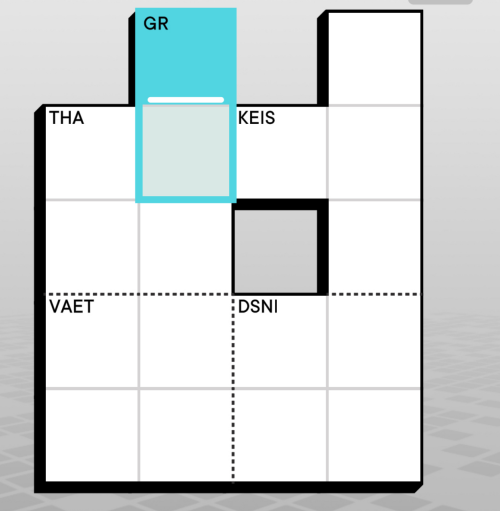
It defeats logic if you start somewhere in the middle although it is technically allowed. The importance of beginning with a zone that entails a word’s starting point is that it allows for easier word-guessing and formation as you follow up.
For instance, in the screenshot below, if you start with an obvious starter zone like R-G you get a cue to solve two adjacent zones — the square “O” zone formed by the “TAH” letter group and the “T” zone formed by “ESKI” letter group.
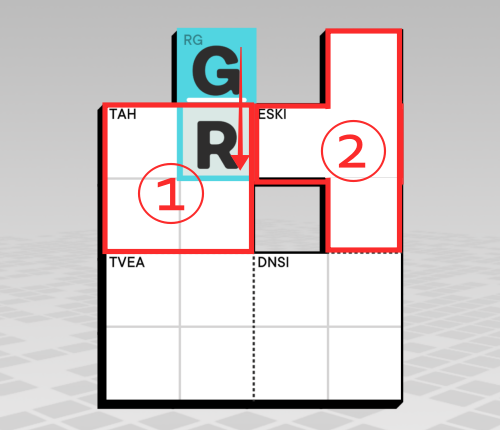
Going by this approach, another good zone to start your gameplay is the “TAH” zone starting on Row 2, Tile 1 or the “TVEA” zone starting on Row 4 Tile 1. Of course, everyone has their own favorite way to start a game, like starting from a corner at the top or with the shortest word on the grid.
Solve word by word
Rather than leaving multiple words half-finished, it is smarter to solve word by word on Knotwords as you’d on Crossword. As you make your moves, you might have to adjust your guesses by replacing letters (like you change or replace numbers on Sudoku) occasionally to satisfy the conditions laid down by the preset letters in different zones. This is a natural and inevitable course of action that follows the intersection and overlapping of the letters in multiple zones.
Take a note of the gameplay below. While solving the grid, word by word and zone by zone, “TANS” satisfies the conditions of the game until you come to “TVEA” zone. Here, the system cues that only “V” or “E” can be input in Row 4, Tile 2.
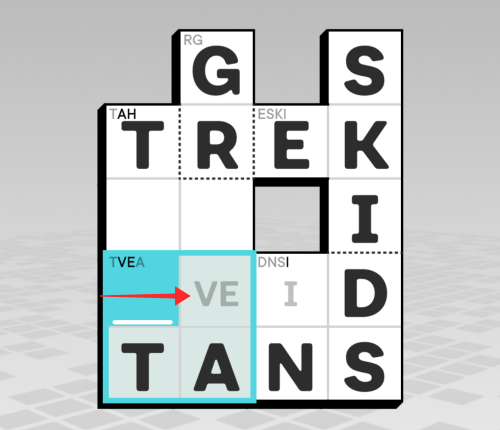
So, you are required to replace “A” in Row 5, Tile 2 with “E” to form a valid word in Row 4 as shown below. Solved zones “TVEA” and “DNIS” zones thus together form two meaning full words, and are part of partially solved zones above, all the while meeting the conditions of the preset letters they carry.
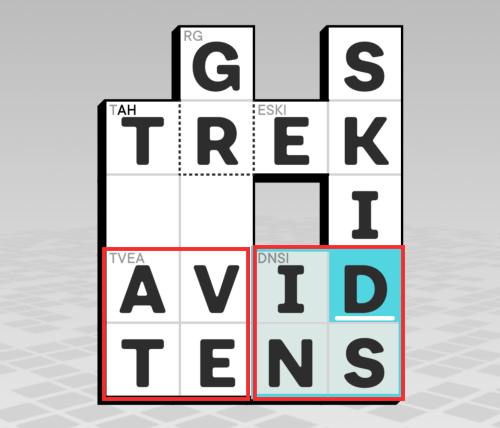
Because the words are of different lengths and the multiple words that satisfy the given conditions based on your gameplay, there can be several sets of solutions for a given Knotwords puzzle.
Overcome bottlenecks using “Hint”
Knotwords “streak” is a serious matter for a regular player because the pattern of the game sees to it that the grid gets larger and the words in them get more knotted with each new game. If you play the daily Knotwords, the game will be tougher tomorrow than it is today. So, times inevitably come when you might need just a little bit more information than what is given by the letter groups in various zones.
But, don’t worry, even in the simplest or hardest of Knotwords puzzles, you can access “Hints” to exit bottlenecks. To get clues, tap a tile to select it.
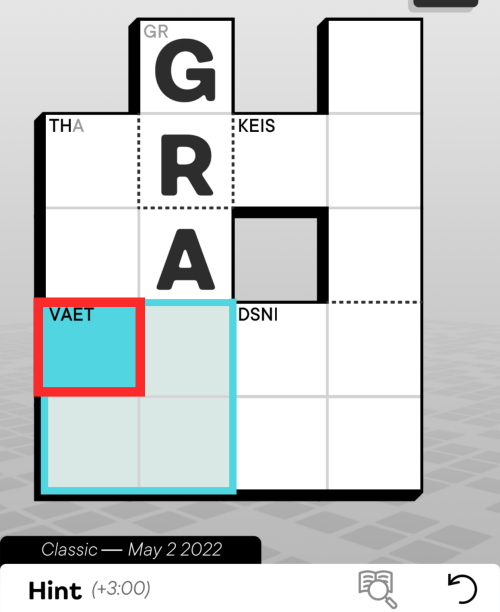
Tap the Hints text on the top left side of the on-screen keyboard.
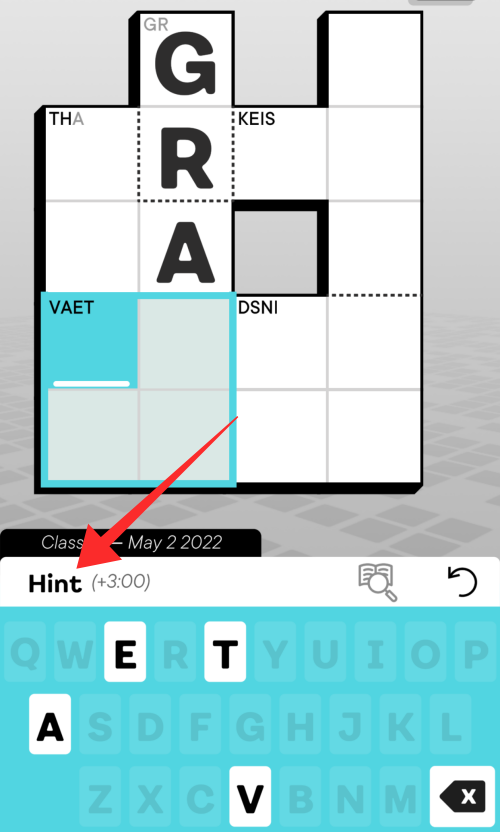
The Knotwords bunny will ask you if you want a hint for the word “across” or “down” depending on the tile you selected. Select the row or column you want a hint for.

The bunny will give you the definition of the hidden word to help you solve the row or column.
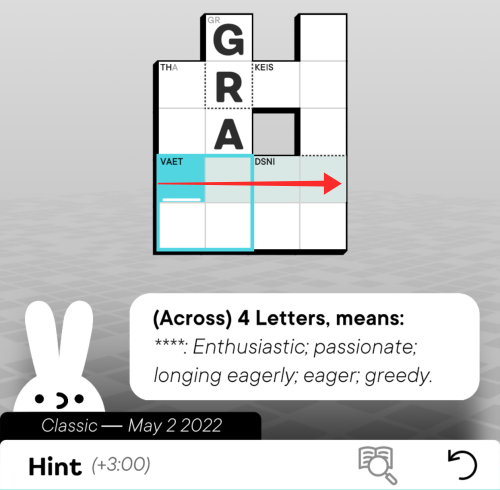
But, the hints come with a price, though. Your Knotwords score is weighed on the basis of the time taken to solve the puzzle. With each hint you take, 3 minutes get added to your total game time. So, in a game like Knotwords where your wits grapple with the witty puzzle grid and time keeps ticking and tracking, it is recommended not to use the hints option unless it is absolutely necessary.

A special shout out to the cute little cheerleader bunny who goes absolutely nuts with praises and flailing ears when you win a game! You are the best cheerleader anyone can ask for, lil bunny!
Knotwords tips to know
Knotwords is designed and encouraged to be a “pen and paper” game according to the designers themselves. The differing word lengths, for instance, give rise to the potential for multiple answers to be acceptable guesses when you are mid-game. The best preparation you can give yourself is the time to map the grid out on a piece of hard paper and figure it out using the available hints.
Keep an eye on the on-screen keyboard as it always only highlights the useable letters in a selected zone as you play. The highlighted letters on the keyboard along with the progress at that point in time will help expedite the process of making guesses in a Knotwords grid.
If the system given hint still gives you no out from the row or column you are stuck on, do not hesitate to look up “one word for” the given definition. You can weed through the answer dear ol’ Google gives you to match against the allowed letters in the problem word’s unsolved zones.
Is Knotwords free?
Knotwords is a mobile game that you can download for free from official app markets like App Store and Play Store. The game comes in two versions — free and paid.
The free version gives unsubscribed players access to one Daily Classic puzzle in addition to 10 monthly puzzles. Pretty amazing already, isn’t it? But, there is more in store for subscribers.
For paid users, Knotwords offers various other benefits such as more complicated challenges like the vowel-restricted Daily Twist mode and the adjectives-only Tricky Puzzles mode apart from unrestricted access to the game archive.
There are two subscription options available for Knotwords. One is a one-time purchase in the app for a total of $11.99. If you wish for a more temporary subscription, then Knotwords has got for you an annual subscription plan which you can make for just $4.99.
Are you eligible to play the free daily Knotwords challenge?
Anyone who downloads the mobile app from the App Store or Play Store can play Knotwords for free albeit with limitations. Unsubscribed players are set up with a daily cap of 1 game with a bonus set of 10 puzzles per month. If you enjoy the rhythm of Wordle daily, then, Knotwords free-version already offers the best and cost-free package for you to enjoy the logical word puzzle.
However, if you decide to subscribe, you are in full the full ride including access to the Knotwords archive to play older Knotword challenges. The subscription can be made for an $11.99 outright purchase or an annual subscription for $4.99.
Is Knotwords an online game?
Knotwords is not an online game. Because of the recent interest and massive reception of web-based word games like Wordle, it is only natural for us to assume that Knotwords is also an online game that you can play using web browsers on smart devices and computers.
However, Knotwords is an app-based game that you can play only by downloading its official app from app markets like App Store or PlayStore, apart from PC-game portals or official app stores.
Is Knotwords similar to Wordle?
Knotwords is similar to Wordle in that both are word guessing games. Since the former is deeply inspired by the latter, the developers have imbibed the spirit of “daily” challenges in the free version of the game. For players of the free version, Knotwords is limited to 1 daily challenge and 10 monthly challenges. The game can also be shared as “blank” puzzles on social media platforms to inspire interest in others in your network. That is as far as the resemblances go.
The developers have at once levied a hefty load of anticipation on the very same attribute of “daily challenge” and shareable “blank” puzzles to engender an organic players’ syndicate who would promote the game in a format similar to “word-of-the-mouth” disseminations.
Are you excited about this new hybrid word game? Share your thoughts with us in the comments.

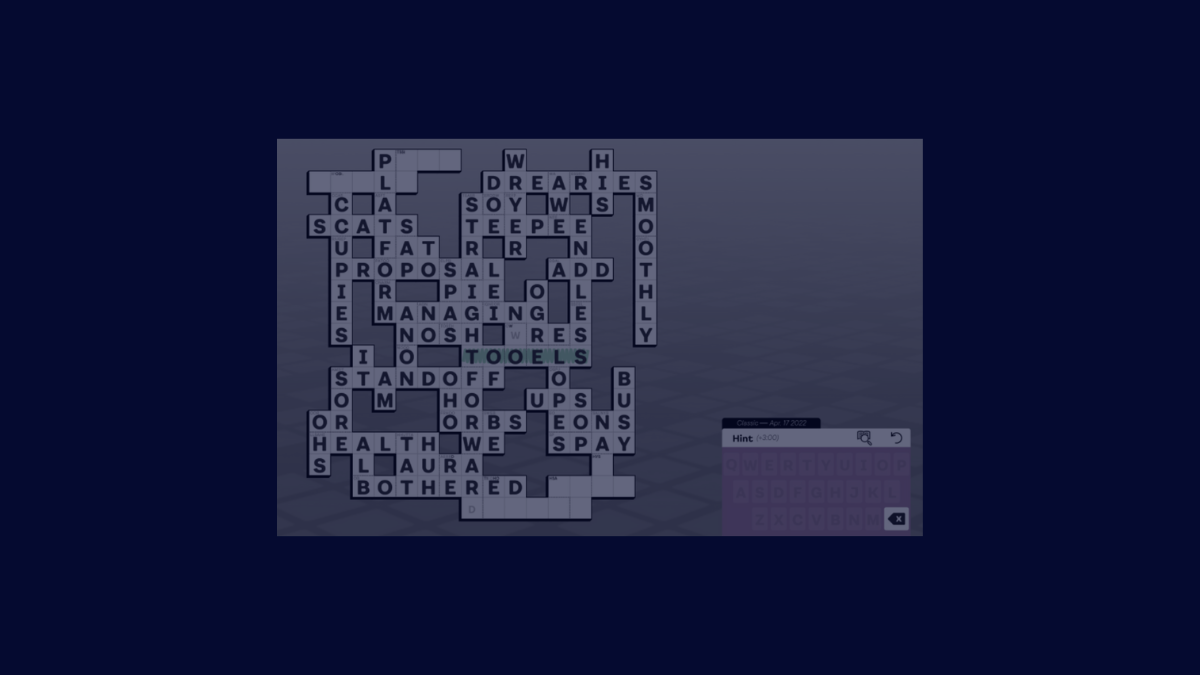
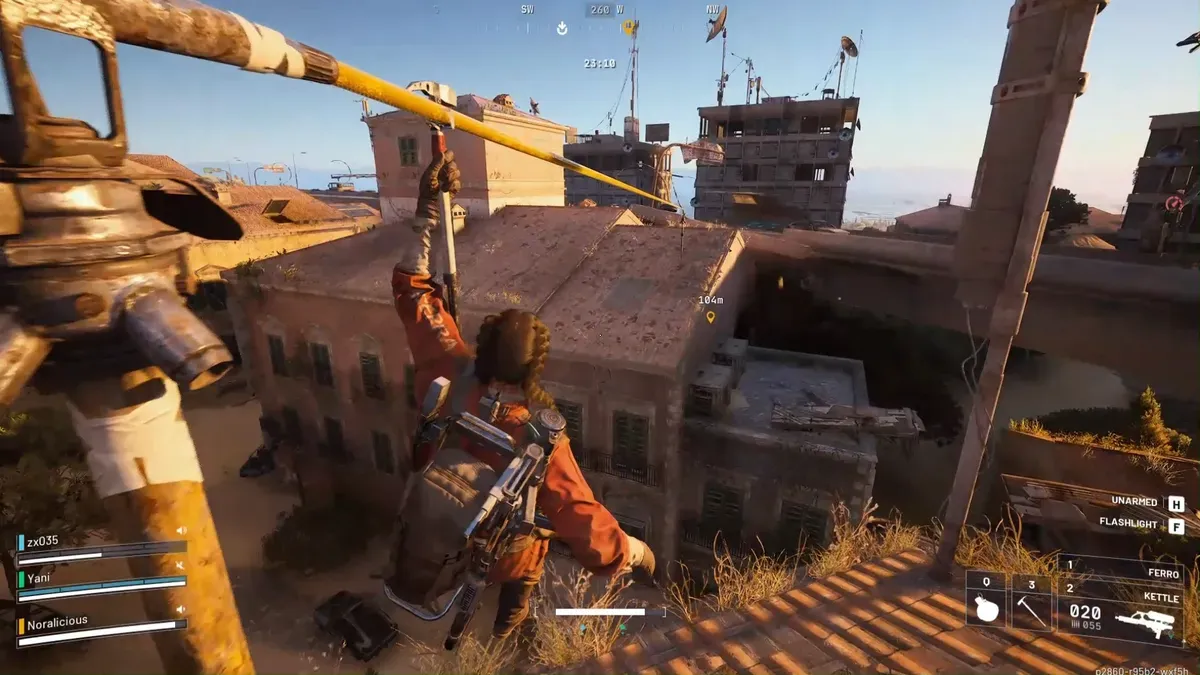

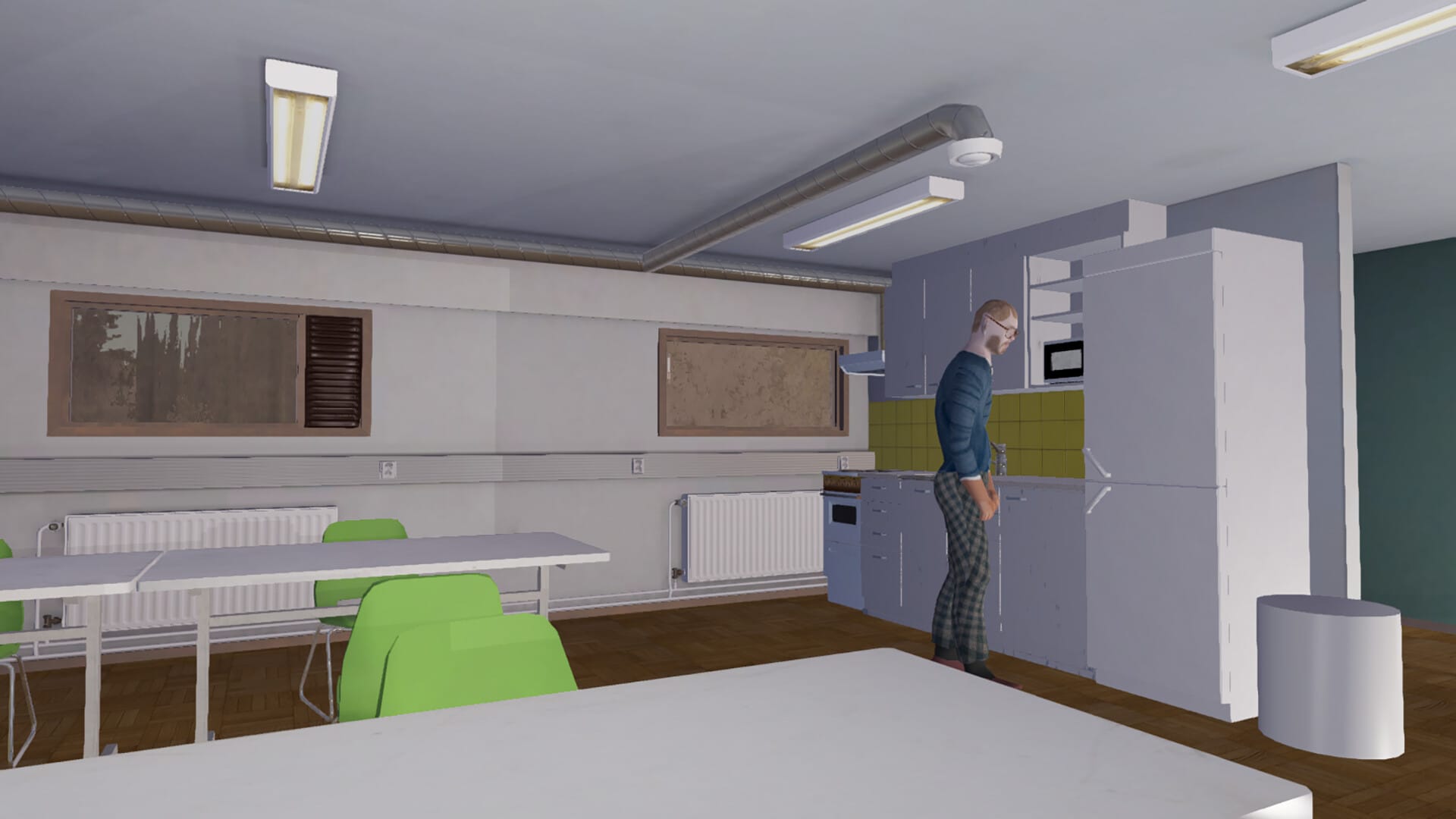

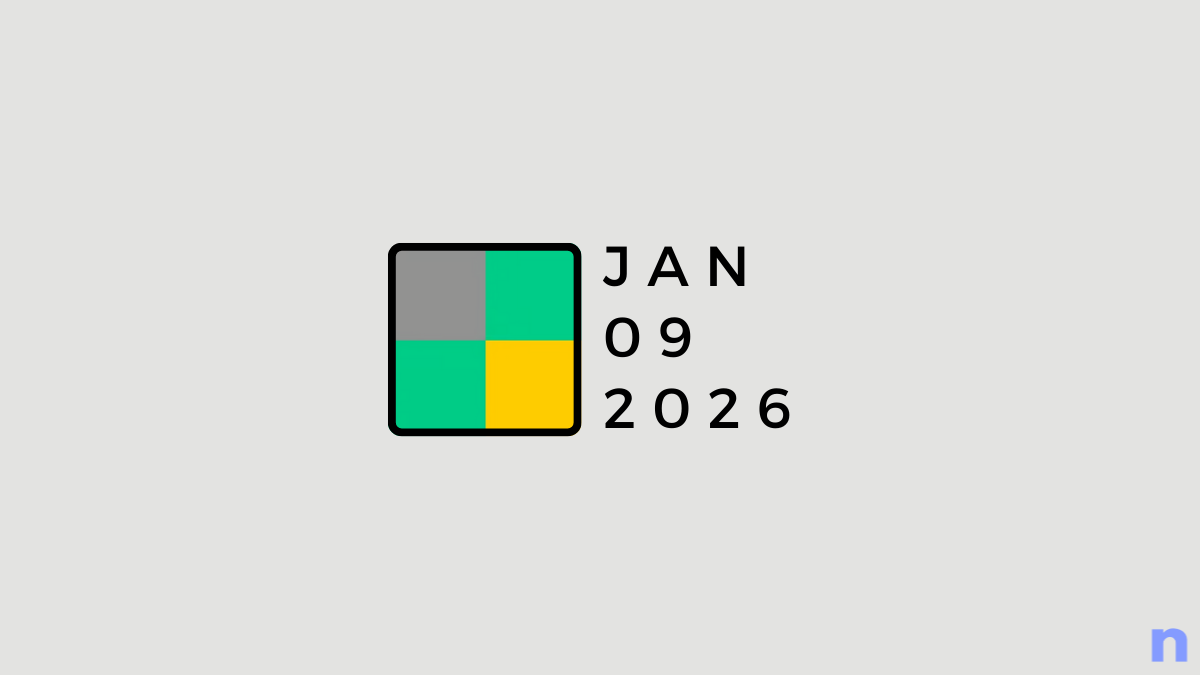
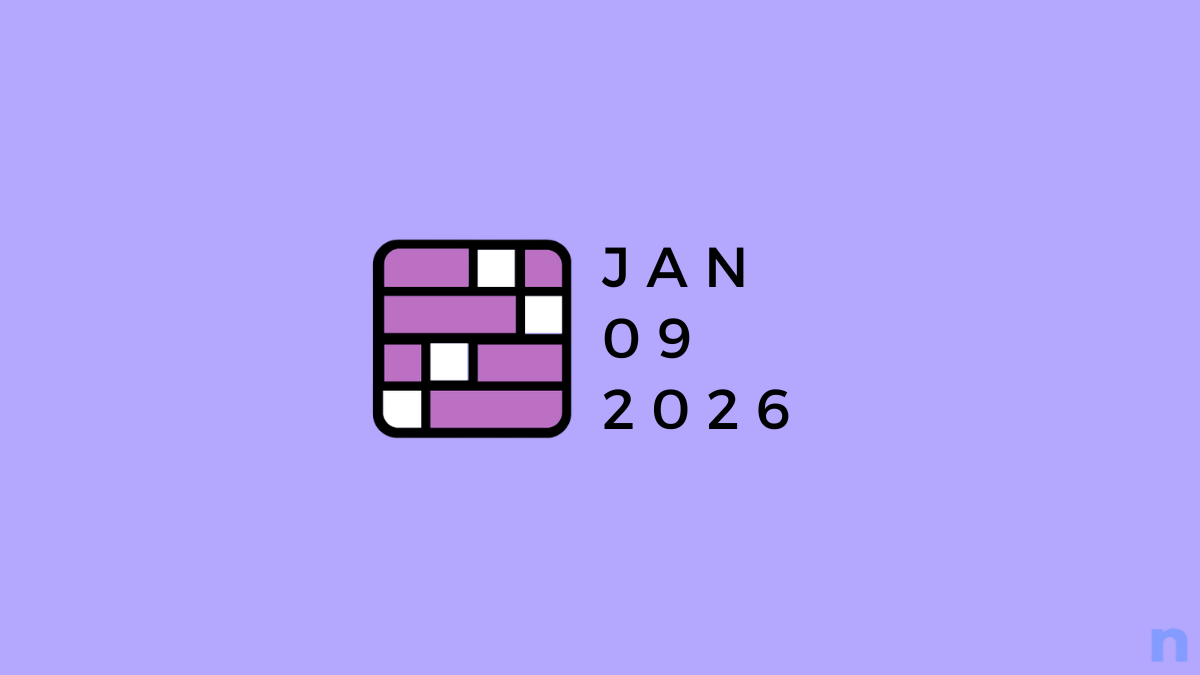
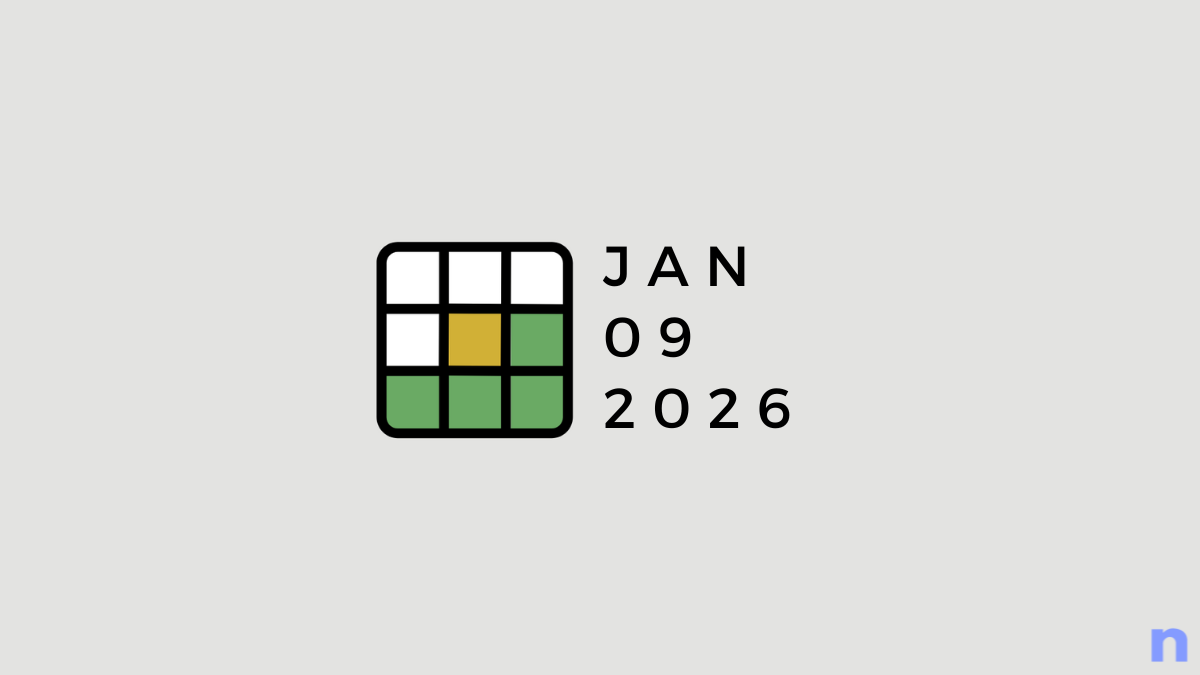
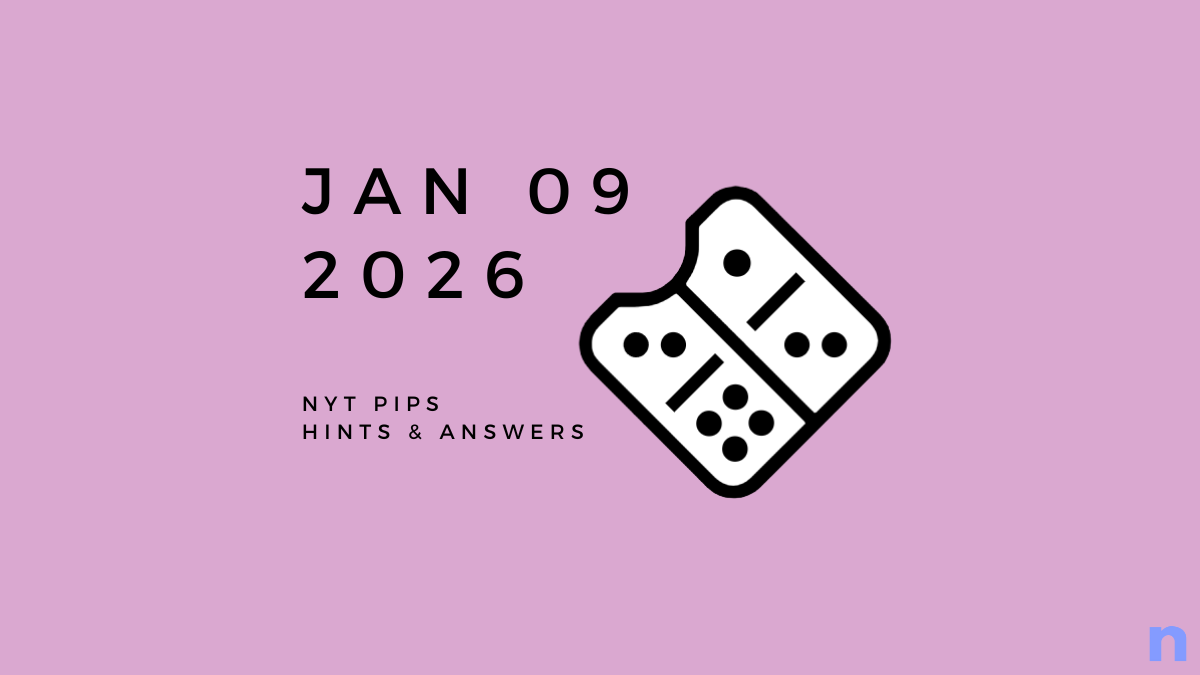


Discussion